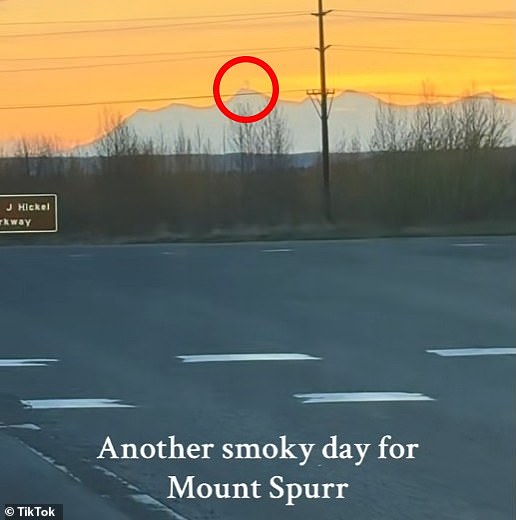More than two dozen earthquakes have rattled a massive Alaska volcano over the last two days, potentially signaling an imminent eruption.
Mount Spurr, which is 11,000-foot-tall and located 81 miles from Anchorage, has been showing signs of unrest for more than a year.
Scientists have been closely monitoring this volcano for signs of an eruption, which they say could happen in a matter of weeks or months.
Over the past 48 hours, 28 small, shallow earthquakes have been detected beneath the volcano.
This is a continuation of heightened seismic activity that has been ongoing since April 2024, which experts believe could be a sign that new magma is rising closer to the surface.
Mount Spurr has also been emitting gas and steam from its summit crater, which an Anchorage resident recently caught on camera.
A local in Anchorage shared a video Wednesday showing gray vapor rising from the volcano’s peak, caused by magma heating underground water.
The Alaska Volcano Observatory (AVO), which has been tracking Mount Spurr’s activity, said ‘clear web camera views showed an occasional vapor plume at the summit’ in a Wednesday update.

In the video posted Wednesday, Mount Spurr looms in the distance with a cloud of gray vapor rising from its peak

When Mount Spurr blows, it will spew an enormous cloud of black ash 50,000 feet into the sky, and this will pose a significant hazard to airplanes because the particles are highly abrasive. The last time Mount Spurr erupted was in 1992 (pictured)
‘Although low-level unrest continues, no changes have been observed in the monitoring data to indicate that the volcano is moving closer to an eruption,’ the update states.
But Anchorage, home to nearly 300,000 people, is bracing for Mount Spurr to blow and have stockpiled everything from groceries to water and protective gear.
If the volcano does, ‘it would be explosive,’ Matt Haney, scientist-in-charge at the Alaska Volcano Observatory (AVO) at US Geological Survey (USGS) told DailyMail.com.
This event would spew multiple plumes of ash rising as high as 50,000 feet into the air, Haney added.
Each ash-producing explosive episode would last three to four hours, and the resulting cloud could blanket the city of Anchorage and other nearby communities in a thick layer of dust.
This would force international hubs such as Ted Stevens Anchorage International Airport (ANC) and potentially Fairbanks International Airport (FAI) to shut down.
Halting all incoming and departing flights at these airports could have a ripple effect across the country, resulting in widespread delays and cancellations and even disrupting the global supply chain.
Hundreds of planes fly over Anchorage and Fairbanks per day, and it’s not just passenger flights that would be impacted. ANC is the fourth-busiest cargo airport in the world, with more than 8,000 cargo flights passing through each month.

Mount Spurr , an 11,000-foot-tall stratovolcano that sits 81 miles from Anchorage, has been showing signs of unrest for more than a year
The eruption would also produce destructive mudslides and avalanches volcanic debris racing down the volcano’s side at over 200 miles per hour, ‘but fortunately, there are not any communities in that radius that would be affected,’ Haney said.
The event would most likely occur at the volcano’s Crater Peak side vent, which last erupted in 1992.
During that eruption, ANC shut down for 20 hours while the ash cloud hung over Anchorage. It darkened skies in the middle of the day, and ultimately settled an eighth of an inch thick across the city.
The Municipality of Anchorage reported nearly $2million in damages, office closures and cleanup costs from the August eruption.

If Mount Spurr’s activity continues to ramp up, the next sign of an eruption will be a volcanic tremor. Pictured is Mount Spurr in March. showing steam blowing from the crater
No one was killed by these events directly. But two heart attacks, one fatal, from shoveling ashfall were reported in Anchorage.
Since last April, Haney and his colleagues at the AVO have been tracking shallow earthquakes, ground deformation, and gas and steam emissions at Mount Spurr.
All of these are signs that a volcano is getting ready to erupt.
If Mount Spurr’s activity continues to ramp up, the next sign of an eruption will be a volcanic tremor, Haney said.
This would be different from the brief, shallow earthquakes this volcano has already been experiencing.
A volcanic tremor is a longer stretch of ongoing shaking that can persist for minutes to days.
It occurs when magma beneath the volcano begins rising toward the surface as the eruption grows imminent.
The last time Mount Spurr erupted — volcanic tremors began about three weeks before it finally blew.
This article was originally published by a www.dailymail.co.uk . Read the Original article here. .

